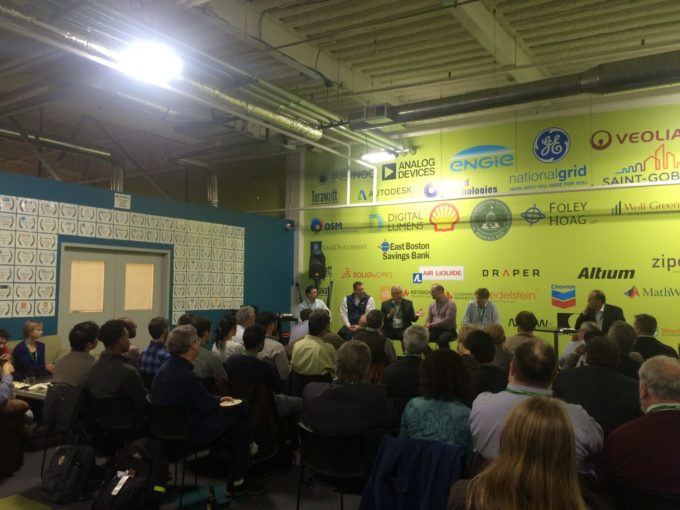As our power system becomes increasingly decarbonized, decentralized and distributed, will microgrids be the new face of electricity generation and transmission?

Last week at Greentown Labs, more than 150 people gathered for a standing-room only panel discussion on the future of the electric grid and how microgrids may play a role in creating innovative solutions to demand/energy response, grid modernization, and grid decarbonization. The panel drew on the expertise of diverse leaders in the utility, energy storage, and corporate sectors. Moderated by Richard Stuebi of NextWave Energy, panelists included: Sean Becker, President and Founder of battery provider Sparkplug Power, a Greentown Labs member company; Mark Johnson, Smart Cities Chief & MW Battery Energy Storage Microgrids Innovator of event sponsor and major equipment and systems provider, Schneider Electric; Ed Krapels, CEO of transmission and microgrid developer Anbaric; Ben Polito, President of Maine-based DC power electronics manufacturer Pika Energy; and Paul Elias, partner at J.M. Forbes & Co. and commissioner of an island utility.
To begin, microgrids are geographically localized grids that can disconnect from the traditional grid to operate autonomously, helping mitigate grid disturbances or peak demand in order to improve grid resilience.
Why Microgrids? Here’s what you need to know:
- Microgrids support a more flexible, efficient, and manageable electric grid by enabling integration of distributed energy resources, largely renewable energy deployments such as wind farms and solar arrays.
- Moreover, by using local sources of energy to serve local electric loads, microgrids have the additional benefit of reducing energy losses from transmission and distribution, further increasing efficiency of the overall grid.
- Benefits of microgrids that extend to utilities and the community at large include: lowering greenhouse gas (GHG) emissions and decreasing stress and energy loss on the transmission and distribution system, the cost-savings of which are passed on to the consumer.
Panel moderator Richard Steubi kicked off the discussion by identifying four major driving forces that have brought microgrids to the forefront of grid modernization discussions:
- Exponential increase in digital innovations (over the past 30 years) has further compounded the interconnectedness of devices and assets (e.g., block chain, big data, IoT).
- The economics of distributed energy sources has been improving steadily, particularly over the last two decades.
- Increasing consumer demand for customer engagement and control regarding decisions about energy usage.
- Increasing number of threats to the centralized grid are deepening the need for improved resiliency.
Tips for startups:
- The electric utility industry is conservative. By partnering with an established company or corporate in the sector, your flexibility and innovation offer something new.
- Moreover, by partnering with a corporate like Schneider Electric, you gain access to a reliable, long-term partner who already has an established customer base and will likely be a beneficial, trusted relationship for many years to come.
- There is plenty of “white space” in the grid to be filled by technology innovation.
- Look for funding opportunities with strategic corporate partners. The energy industry may not be as attractive to venture capitalists as less capital-intensive industries, making corporates a more reliable funding source.
Important questions moving forward, raised by panel attendees:
- Is energy storage going to be the precipitating event in bringing building-level microgrids to life? Is it the enabling technological factor?
- Mark Johnson (Schneider Electric) and Ben Polito (Pika Energy), contend that energy storage is a microgrid-enabling technology to the extent that battery life increases and the cost of deployed energy (solar/wind) continues to drop.
- “Storage” is not limited to lithium-ion batteries, however, whatever storage solution is employed must meet the market needs of a specific geographic region.
- How are microgrids going to penetrate the larger market of buildings that are owned by different entities and house diverse, unconnected tenants with varying end uses?
- If it’s not a public utility, but there are multiple customers, who has authority to control the system? Who “owns” the microgrid?
Thank you to all of our panelists for their participation and expertise, and to Richard Steubi for moderating this discussion. A special thank you to Schneider Electric for sponsoring this panel, enabling a fantastic exchange of ideas and challenges that everyone in the room was enthusiastic to address. This panel was part of Greentown Labs’ Strategic Partnership Initiative, directed by Katie MacDonald.
About Schneider Electric:
Innovative grids, renewable generation and empowered consumers are here – and they shape our vision of a decarbonized, decentralized, and digitized world. Our innovative solutions enable energy world’s players to embark on a digital journey to create efficient and sustainable networks, deploy local production and create value beyond the meter. It’s all made possible by Schneider innovation at every level in the grid across connected products, edge control and apps, analytics and services.
About Greentown Labs Strategic Partnership Initiative:
Collaboration between early-stage innovators and large corporations can dramatically improve the odds of bringing transformative energy innovations to market. For energy startups, learning how to navigate a potential corporate partner’s organizational structure and build an effective value proposition or partnership strategy requires deeper understanding of these potential customers. On the other side, large corporations scout widely for startups of strategic interest, but there can be challenges that come from the product being developed in isolation from market applications. By partnering with startup companies, large corporations improve their chances to create new products and open market opportunities. To learn more, email Katie at kmacdonald@greentownlabs.com.

